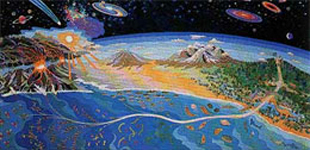William
Saturno
Boston University
National Geographic Explorer
William A. Saturno is Assistant Professor, Department of Archaeology, Boston University. His research interests include mesoamerican archaeology, landscape archaeology, remote sensing, and GIS, art and iconography, complex societies, and archaeology in popular culture. His current titles and affiliations include: Director, Proyecto San Bartolo, Instituto de Antropologia e Historia, Guatemala; and Research Associate, Peabody Museum, Harvard University.
Following his undergraduate degree at University of Arizona, Saturno received his Ph.D. Anthropology from Harvard 2000 Harvard University. Whilestudying and teaching at Harvard he received the Harvard University Award for Excellence in Teaching (Awarded nine times from 1995 - 2001).
FIELD RESEARCH
Proyecto San Bartolo
Director - ongoing multi-disciplinary archaeological investigation and conservation of the site of San
Bartolo, Guatemala. San Bartolo is a newly discovered small Maya center in the northeastern Peten
containing extensive Preclassic murals, the earliest thus far encountered in the Maya area. This multi-year
project promises to change our conceptions of early Maya civilization and shed new light on the broader
processes of urbanization and the formation of complex society.
Corpus of Maya Hieroglyphic Inscriptions
Director of Digital Technology - designed and maintained Corpus Web Site, in charge of the digital
archiving of all Corpus materials. Begana Geographic Information Systems (GIS) database for analysis
and presentation of all Corpus data. Survey and reconnaissance of Lowland Maya sites. Photography of
inscribed monuments. Ian Graham, Director.
Rio Amarillo Archaeological Project
Field Director - conducted the survey and mapping of Rio Amarillo, a "subordinate center" located 20 km
west of Copan, Honduras. Assessed recent river and looter damage, collected sculpture and dressed stone
from river cut. Conducted test excavations throughout the site as well as the intensive excavation of elite
and non-elite residential structures. Laboratory analysis of collected materials. Dr. William Fash, Director.
Harvard University Archaeological Field School, Copan, Honduras
Teaching Staff - directed survey, mapping and test excavations of Group 9J-5, a Type IV residential group
located at the western end of the sacbe running through the Principal Group, Copan, Honduras.
Archaeologist - conducted survey, mapping, and test excavations of Early Classic through Terminal
Classic residential complexes in the Rio Bravo region of northern Belize.
Proyecto Arqueologico de San Lorenzo Tenochtitlan Researcher - conducted regional survey and mapping of outer hinterland of San Lorenzo. Laboratory
analysis of fatty acid residues from ceramics excavated during the 1991 and subsequent field seasons to
address questions dealing with Olmec subsistence.
Tuxtlas Archaeological Survey Project
Archaeologist - conducted regional survey, mapping and surface collections of Early Formative through
Postclassic Period sites in the region between the Tuxtlas Mountains and the Gulf of Mexico, Veracruz,
Mexico. Laboratory analysis of collected ceramics and Iithics.
University of Arizona Field School at Grasshopper Pueblo
Archaeology student - participated in archaeological survey and excavations of Pueblo III period room
blocks at Grasshopper Spring Pueblo; laboratory analysis of collected ceramics and lithics.
|
The ancient Maya are widely recognized for their astronomical knowledge. Knowledge evident in both the early (800BCE) construction of celestially aligned architectural complexes and the late (1400CE) production of screen-fold almanacs known as codices.
This talk details recent archaeological research at the Classic period Maya site of Xultun, Guatemala—focusing on the archaeology of a rare eighth-century mural discovered within the Los Sabios group. The mural depicts a courtly scene in which several black-painted individuals (labelled, Taaj meaning obsidian) sit in audience with the Xultun king. More importantly however are the assortment of complex texts that were painted over and around these figures.
The tables and numerical matrices constituting these micro-texts parallels those from the much later colonial-era codices. Pulling from archaeological excavations of the architectural group and the content of the mural itself, I shed light on the occupants of the group as the ancient specialists featured in the mural imagery. In doing so, I also explore the links between these figures and the calculation and transmission of calendrical and astronomical knowledge during the height of Maya civilization. |

|




